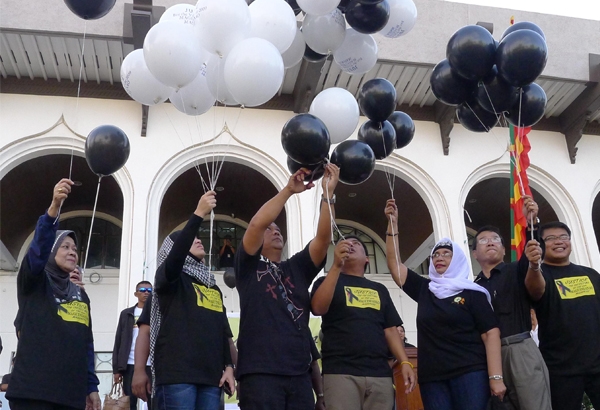Mindanao execs commemorate Maguindanao Massacre
- Details

COTABATO CITY, Philippines --- Calls for the speedy prosecution of the suspects in the November 23, 2009 “Maguindanao Massacre” reverberated through Central Mindanao as journalists, local officials, clerics and peace activists commemorated Friday the third anniversary of the country’s worst election-related violence.
Maguindanao Gov. Esmael Mangudadatu, chairman of the provincial peace and order council, led a brief candle lighting ceremony on a hill in Salman area in Ampatuan town where gunmen, allegedly led by members of the Ampatuan family, slaughtered 58 people including his spouse, Genalyn.
Mrs. Mangudadatu left the governor eight children, the eldest of them named Datu King, who is aspiring for the vice-mayoral post of Buluan town in the second district of Maguindanao.
Close call
A powerful improvised explosive device rigged on a motorcycle was found along a stretch of the highway linking Isulan, Sultan Kudarat to the massacre site, the route Mangudadatu and his entourage took as they motored Friday to the venue of the candle lighting activity.
Intelligence operatives of the Sultan Kudarat provincial police are still trying to determine if Mangudadatu was the target of the supposed bombing.
The IED, placed inside the utility box underneath the seat of the abandoned motorcycle, was fashioned from two 81 MM and two 60 MM mortar projectiles rigged with a blasting mechanism attached to a mobile phone.
Senior Supt. Rolen Balquin, director of the Sultan Kudarat provincial police, said the bomb could have been set to explode, but failed while Mangudadatu’s convoy was passing by.
The presence of the IED-laden motorcycle along the highway was noticed by bystanders, just minutes after Mangudadatu’s convoy had passed through.
Responding Army bomb experts said the IED was enough to kill or injure anyone inside its effective 50-meter blast impact radius.
Deadly sojourn
Mrs. Mangudadatu, accompanied by relatives, two lawyers, and journalists, was on her way to the provincial capitol in Shariff Aguak town to file Mangudadatu’s certificate of candidacy for governor on November 23, 2009 when their killers flagged them down, herded them to the Salman hill and, there, shot them with machineguns and assault rifles.
Thirty two journalists were killed in the attack, which sparked condemnations from international organizations, including the United Nations, the Japan International Cooperation Agency, the European Union, and the governments of Australia, the UK and the US.
Among those jailed now and is being prosecuted in connection with the massacre is Andal Ampatuan Jr., also known as “Datu Unsay,” their clan’s supposed candidate for governor of the province during the area’s 2010 gubernatorial elections.
The Ampatuan clan ruled the province from 2001 to 2010 with “zero” tolerance for political opposition. While their leaders are now detained in connection with the massacre, the Ampatuans still wield political control over seven vote-rich towns in the second district of Maguindanao.
Mangudadatu said he and his relatives are still seeking justice for their slain kin.
Stigma
Mangudadatu said he is saddened by the “stigma” and adverse effects of the massacre to the innocent Ampatuans, some of them supporting his bid for a second term.
Journalists covering Cotabato City, Maguindanao and other areas in the Autonomous Region in Muslim Mindanao also held a separate commemoration of the third anniversary of the massacre at the 32-hectare ARMM compound in Cotabato City.
The event, jointly organized by ARMM Gov. Mujiv Hataman and his chief-of-staff, John Magno, their Regional Communications Group, press clubs in Central Mindanao, and popular peace activists, was capped with a tree planting activity on the grounds of the regional government center.
Those who attended the event were Hataman’s spouse Sittie Djalia, Peter Koeppinger of the Konrad Adenauer Stiftung of Germany, and Oblate missionary Eliseo Mercado Jr., director of the Institute for Autonomy and Governance.
Hataman, representatives of different media outfits, and hundreds of ARMM employees also released black and white balloons to show support to the quest for justice of the families of the victims.
Protecting journalists
“The Maguindanao Massacre was an eye opener for all of us. The security situation we are in, such as the existence of warlords and private armies in the ARMM, which led to the massacre, is something that we are trying to address seriously,” said Hataman, who was appointed caretaker of ARMM by President Benigno Aquino III in December 2011.
Hataman said the ARMM police command, led by Chief Supt. Mario Avenido, is ready to provide security to journalists covering the autonomous region that are under threat.
The newly-installed commander of the Army’s 6th Infantry Division, Major Gen. Ronnie Ordoyo, said the 6th ID is also ready to help secure journalists working in Central Mindanao.
Culture of `firepower’
Many of the ruling elites and political clans in the autonomous region are known for their culture of stockpiling firearms both for protection against rival groups and as status symbol.
By police and military estimates, each of the more than 100 mayors in the autonomous region has no fewer than 50 assault rifles and shoulder-fire grenade launchers.
Provincial governors in the area, touted as more influential and wealthier than their constituent-mayors, are always assumed to have more guns in their arsenals.
Hataman said part of the reforms they are trying to introduce into the ARMM is putting in place a strong justice system in the region to benefit local residents, regardless of their religious belief.
Clerics that led Friday’s obligatory worship rites at Mosques in many parts of the ARMM also led prayers for peace and for justice for the victims of the Maguindanao Massacre.

